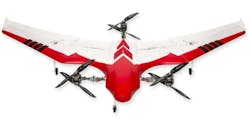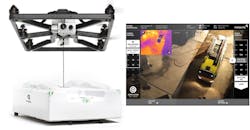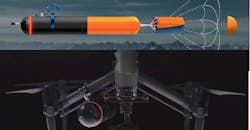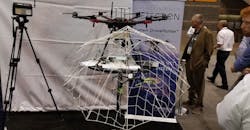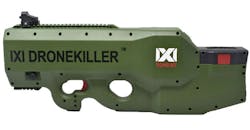AUVSI’s annual Xponential show was held this year in Chicago. As usual, there were plenty of drones and drone technology to be found, including Textron’s Bell Nexus VTOL. This batch of products from the show highlight the launch and landing systems on display.
BirdsEyeView Aerobotics FireFly 6 Pro Use a VTOL Approach
BirdsEyeView Aerobotics FireFly 6 Pro is an electric plane, but its propellers rotate providing VTOL support that only requires a 10- ×10-ft. area for takeoff and landing. It can cover over 600 acres in an hour, which is significantly more area than a quadcopter could handle. The airframe is a combination of aircraft-grade plywood and a carbon-fiber frame. The FireFly 6 Pro is designed to handle a range of sensors from SlantRange’s multispectral for crop measurement to thermal-imaging solutions for data collection.
Fotokite’s Tethered Drone Targets First Responders
Though the FAA now has a commercial drone license, it’s not needed for Fotokite’s Sigma. The rugged suitcase opens to expose the tethered drone and its base that includes the cable reel. The drone can remain hundreds of feet in the air indefinitely since power is supplied from the base. A laptop or tablet can run the control software and display multimedia sensor data from the drone, which has a gimbal-mounted camera and sensor system.
The system easily mounts on a vehicle, enabling it to be quickly deployed at a site. Sigma requires minimal training and can be used almost anywhere to provide situational awareness. The system is able to land automatically if any of the motors fails.
Elistair Ligh-T V4 Tethers Many Commercial Drones
The Elistair Ligh-T V4 is a tethered drone support system that supports a number of commercially available drones, such as the DJI M200 V2 and Yuneec H920, in addition to its own Orion drone. Previous versions of the platform have been used in over 50 countries. Drones have a maximum altitude of 70 m and the system can deliver up to 1200 W of power. A micro tether unit is attached to a drone and the unit is connected to the tether cable. Tether units are drone-specific. As with the Fotokite tethered system, the Ligh-T V4 doesn’t require an FAA drone license to operate in most environments.
Target Arm Talon Offers Moving Launch and Recover of Most Drones
Target Arm’s Talon may look like it’s stabbing a drone, but its system is designed to gently launch and capture drones even from a vehicle moving at over 60 miles per hour. It can handle all types of drones that will fit within its confines. The Universal Launch and Recovery (ULaR) system controls the opening and closing of the pins. The approach is scalable to larger drones.
Indemnis Nexus Drop Drones Via Parachute
The Indemnis Nexus is a parachute system designed for drones. The system attaches to the drone and detects when it’s falling, deploying the parachute automatically. Most drones track fuel or battery levels, and many will attempt to return to base, but sometimes that’s not possible. This system protects the drone and bystanders by landing safely even if there’s total power loss. The parachute ejects such that it will not entangle the drone’s propulsion system.
Fortem DroneHunter Captures Other Drones
Fortem Technologies’ DroneHunter is an autonomous drone remediation system. It’s a drone that plays Spider-Man and captures unwanted drones in a net. The system employs the company’s TrueView radar system to track other drones. The Fortem drone then fires a special gun containing the net that envelopes the target drone, and subsequently tethers the captured drone to the ground safely.
IXI DroneKiller Disables Drone GPS, Command and Control Systems
IXI DroneKiller from IXI Tech is a lightweight, handheld device that uses RF jamming to disrupt command and control (C2) links as well as a drone’s GPS. It can detect and disrupt WPAN/LAN communication. The sensor system has a 30-degree cone and an 800-m range. DroneKiller can operate for eight hours in sensor mode and four hours in active jamming mode.

